

Regional weather has been favorable for blue mold development for most of the past month, but to our knowledge there are still no reports of blue mold activity in the Ohio River Valley or Tennessee River Valley. Our winds have prevailed from the south, rather than the southeast where blue mold is active in flue cured production. This southerly route has much less potential to acquire and maintain viable spores before reaching us, thus greatly reducing the potential for blue mold in our region if this is the only route of spore introduction.
Also, there is no evidence available to us that blue mold has been imported into the region on transplants this season or that it has over-wintered here. Considering the weather of the past month, had the pathogen been introduced with plug-plants, by now it probably would have been widespread in those plantings and into surrounding communities. However, shipments of finished plants from the southeast may have been delayed, and may yet arrive.
Significant blue mold activity is occurring in flue cured tobacco from Florida into southern Virginia. That blue mold is a threat to our region under two conditions. One, we import plants from those areas. Or two, there is a change to easterly or southeasterly winds. Basically, we have blue mold on our east flank and as long as the disease is active there, we need to be prepared to react quickly to a change in winds coming from the southeast or east. So stay in touch, frequently and regularly, with the warning system if you are relying on it for current information to help with your decisions.
Transplanting to the field in our region has been slowed markedly due to frequent and heavy rains, increasing the potential staging areas for blue mold and other diseases to develop. Adequate fungicides are not labeled to protect against all the diseases that could develop under these conditions. Thus, growers are urged to take steps to reduce leaf moisture through careful management of ventilation (get air to them to help dry the leaves and stems) and keep in place a regular fungicide spray program. Regular fungicide spray schedules should be maintained in all transplant production systems - See issue 943 of Kentucky Pest News (March 18, 2002) Weekly fungicide sprays in the field are not warranted at this time for blue mold control, based on the information available to us, unless a southern transplant connection exists with the crop. However, crops should be scouted twice weekly for evidence of bacterial and fungal diseases. If sprays are needed, see issue 948 of Kentucky Pest News (April 22, 2002) for the foliar fungicide options labeled in Kentucky for use in the field.
For the latest blue mold status and other tobacco disease information, check the KY Blue Mold Warning System.
![]() http://www.uky.edu/Agriculture/kpn/kyblue/kyblue.htm
http://www.uky.edu/Agriculture/kpn/kyblue/kyblue.htm
 Strong and aggressive activity from angular leaf spot
could be occurring in traditional tobacco plant beds. We
have received several reports from agents in northern and
eastern Kentucky that this disease is very active, especially
in beds over-fertilized with nitrogen. Streptomycin sprays
at 100 ppm can greatly reduce infections, but they should
be applied to insure complete coverage. Historically, best
results in controlling this disease have been obtained with
regular preventative sprays rather than rescue
applications, however.
Strong and aggressive activity from angular leaf spot
could be occurring in traditional tobacco plant beds. We
have received several reports from agents in northern and
eastern Kentucky that this disease is very active, especially
in beds over-fertilized with nitrogen. Streptomycin sprays
at 100 ppm can greatly reduce infections, but they should
be applied to insure complete coverage. Historically, best
results in controlling this disease have been obtained with
regular preventative sprays rather than rescue
applications, however.
Two serious cases of angular leaf spot in field plantings were also diagnosed this past week. The previous crop in both cases had been hay, where the potassium levels had not been properly adjusted prior to planting tobacco. Plants under low potassium levels are especially prone to serious angular leaf spot activity under current weather conditions. Symptoms of angular leaf spot in the field are similar to those produced in the bed. Spots are angular in shape, with a yellow halo and brown to black center. Following heavy infections large areas of the leaf appear as if burned. The centers of lesions fall out in time giving the leaf a shot-hole or ragged appearance.
The bacterium causing angular leaf spot colonizes the leaf surface during wet periods and is driven into the leaf during heavy rains or by sandblasting in lighter soils. Preventive sprays with streptomycin at 100 ppm can be very helpful in controlling this disease; the problem is getting into the fields to make timely applications, however. Good coverage is also important, but that can be achieved at this stage with much of the spray equipment available.

 Corn planting since late April has slowed considerably,
due to the wet weather which most areas have
experienced. As of May 12, about 55% of the corn crop
has been planted, compared to 92% for last year and 73%
for the 5-year average. Delayed planting can affect yield,
of course; as of publication date, we are past the optimal
planting date for all areas of the state. Late planting may
also influence disease development. A UK study showed
that delayed planting increases the risk from gray leaf
spot, so be sure hybrids planted late have adequate
resistance to gray leaf spot. The UK Agronomy program
recommends that, for fields planted past June 5, an early-
maturing hybrid should be used. Early-maturing hybrids
sometimes may be developed for more northerly locations
where southern corn leaf blight is not a risk, so be sure to
select for resistance to this disease, as well, especially for
conservation tillage fields with corn planted in 2000 or
2001.
Corn planting since late April has slowed considerably,
due to the wet weather which most areas have
experienced. As of May 12, about 55% of the corn crop
has been planted, compared to 92% for last year and 73%
for the 5-year average. Delayed planting can affect yield,
of course; as of publication date, we are past the optimal
planting date for all areas of the state. Late planting may
also influence disease development. A UK study showed
that delayed planting increases the risk from gray leaf
spot, so be sure hybrids planted late have adequate
resistance to gray leaf spot. The UK Agronomy program
recommends that, for fields planted past June 5, an early-
maturing hybrid should be used. Early-maturing hybrids
sometimes may be developed for more northerly locations
where southern corn leaf blight is not a risk, so be sure to
select for resistance to this disease, as well, especially for
conservation tillage fields with corn planted in 2000 or
2001.
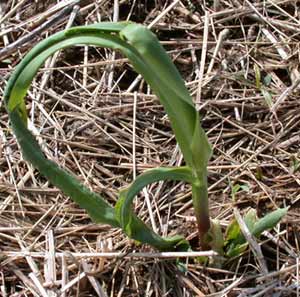 Damage by stink bugs to corn is becoming evident in
many fields. Growing conditions have been poor allowing
only slow corn growth, this does not allow the seedlings
to quickly outgrow the stages vulnerable to stink bug
attack. Corn is most susceptible from seedling through the
four leaf stage, symptoms of the damage have begun to
appear in some central Kentucky counties.
Damage by stink bugs to corn is becoming evident in
many fields. Growing conditions have been poor allowing
only slow corn growth, this does not allow the seedlings
to quickly outgrow the stages vulnerable to stink bug
attack. Corn is most susceptible from seedling through the
four leaf stage, symptoms of the damage have begun to
appear in some central Kentucky counties.
Corn planted under reduced tillage practices following small grains or soybeans may be showing some of the characteristic, but unusual stink bug damage. Damaged plants are stunted with malformed leaves, may tiller excessively, or die. Plants often appear "buggywhip-like", with the youngest leaves not able to completely emerge from the whorl. Other injured plants may show kernel development on the tassel. Some damaged plants often recover with reduced yields, but those that tiller may not yield at all.
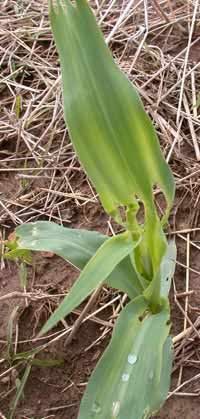 Stink bugs feed with piercing-sucking mouthparts and
inject digestive enzymes into the plants. Damaged plants
will commonly have four ragged holes in a line across one
or more leaves. The damage occurred when the leaves
were rolled together at the base of the whorl. Unlike corn
borer or cutworm caused holes in the leaves, these holes
do not have distinct margins caused by chewing
mouthparts, rather they have yellowed, irregular margins
that appear to have been dissolved.
Stink bugs feed with piercing-sucking mouthparts and
inject digestive enzymes into the plants. Damaged plants
will commonly have four ragged holes in a line across one
or more leaves. The damage occurred when the leaves
were rolled together at the base of the whorl. Unlike corn
borer or cutworm caused holes in the leaves, these holes
do not have distinct margins caused by chewing
mouthparts, rather they have yellowed, irregular margins
that appear to have been dissolved.
Stink bug damage can be confused with herbicide damage. Stink bug damage is usually sporadic throughout the field, while herbicide damage is often more uniform across the entire field. Unfortunately, stink bug damage appears noticeable long after the pest has come and gone. When monitoring corn fields, particularly following small grains or soybeans, watch for stink bugs feeding at the base of the young plants. The stink bugs are found just above the soil line feeding in an upside-down position.
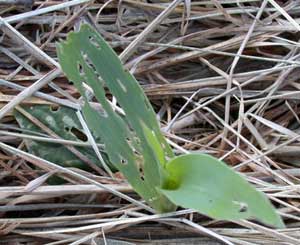 Slug damage to corn has been common in some no-till
fields particularly due to the cool, wet weather. Slug
damage appears to the lowest leaves as oblong holes cut
through the leaf. Often silvery trials are also evident.
Unlike foliar feeding by cutworms and armyworms, most
of the holes are not along the leaf margins. Generally, corn
will outgrow slug damage when temperatures rise, fields
dry off, and growing conditions improve.
Slug damage to corn has been common in some no-till
fields particularly due to the cool, wet weather. Slug
damage appears to the lowest leaves as oblong holes cut
through the leaf. Often silvery trials are also evident.
Unlike foliar feeding by cutworms and armyworms, most
of the holes are not along the leaf margins. Generally, corn
will outgrow slug damage when temperatures rise, fields
dry off, and growing conditions improve.
For more information about corn pests, visit
"Insect Management Recommendations".
![]() Populations of glyphosate-resistant marestail, also known
as "horseweed", were identified in Deleware in 2000 and
West Tennessee in 2001. Preliminary results of a no-till
soybean study in western Kentucky this spring indicate
that burndown applications of Roundup Ultramax at 26
oz/A or 52 oz/A did not completely kill marestail. The
treated marestail plants are pale green and severely
stunted, however, they are showing signs they might
survive. These symptoms are similar to those observed in
other states where marestail resistance was confirmed.
Populations of glyphosate-resistant marestail, also known
as "horseweed", were identified in Deleware in 2000 and
West Tennessee in 2001. Preliminary results of a no-till
soybean study in western Kentucky this spring indicate
that burndown applications of Roundup Ultramax at 26
oz/A or 52 oz/A did not completely kill marestail. The
treated marestail plants are pale green and severely
stunted, however, they are showing signs they might
survive. These symptoms are similar to those observed in
other states where marestail resistance was confirmed.
Based on the history of this field, there were problems in controlling marestail with multiple applications of glyphosate last season in Roundup Ready soybeans. Plants collected from this site are being studied by UK researchers in the greenhouse to help further determine the status of resistance or tolerance of this marestail population.
A similar circumstance was reported last week in a no-till corn field in western Kentucky. Details on this particular situation are still unknown, consequently it is not clear whether this particular case is following a pattern of resistance.
The mild winter and wet spring helped promote emergence and growth of marestail in our region, therefore, applicators need to focus attention on this weed. Early spring applications of Gramoxone Max plus atrazine should control small marestail plants. When applied alone, Glyphosate is preferred over Gramoxone Max (paraquat), yet rate of herbicide is critical. The following table shows labeled rates of selected glyphosate products for managing marestail up to 18 inches in height. Although these rates are listed on the product labels, it is our view that they may too low, particularly given the nature of this growing season.
| Glyphosate Product * | Herbicide Rate/A | ||
|---|---|---|---|
| Marestail Height | |||
| 6" | 12" | 18" | |
| Glyphomax Plus | 24 oz | ||
| Roundup Ultra Max ** | 13 oz. | 20 oz. | 26 oz. |
| Touchdown | 24 oz | ||
| * Consult label for use of additives. | |
| ** The following is a more aggressive rate structure that is being suggested by some Monsanto representatives: | |
| Roundup Ultra Max | Marestail Height |
| 26 oz/A | up to 10" |
| 32 oz/A | up to 14" |
| 40 oz/A | up to 18" |
| 48 oz/A | 18" |
Including 2,4-D as a tank mix partner with glyphosate, may help insure marestail control, particularly if plant exceeds the maximum height recommended for glyphosate. More importantly, 2,4-D can help control populations that are resistant to glyphosate. The fact that 2,4-D labels require a waiting period of 7 to 14 days after application before planting corn, makes this approach less appealing, since we already beyond the ideal time for corn planting.
However, the use of 2,4-D may be feasible for no-till soybeans, particularly considering the size of marestail this late in the season. When using 2,4-D ester, soybean planting should be delayed 7 days for rates up to 0.5 lb ai/A and 30 days for rates > 0.5 to 1.0 lb ai/A. (Consult the 2,4-D label for rate of product and restrictions.)
It will be prudent to monitor marestail infested fields following burndown applications. Following up with a postemergence application of 2,4-D may help control escapes in corn. FirstRate or Amplify at 0.3 oz/A may will help manage escapes in no-till soybeans and may be tank mixed (according to label directions) with certain glyphosate products for postemergence applications in Roundup Ready soybean varieties.

Above normal rainfall statewide during the past six weeks creates conditions that may favor seedling diseases of alfalfa sown in early to mid-April. Three "water molds" are known to cause seedling disease of alfalfa when soils remain saturated for extended periods following seeding: Pythium species, Phytophthora medicaginis, and Aphanomyces euteiches. These soilborne organisms may cause plants to die before emergence or to emerge and then remain stunted, turn yellow and/or reddish, and perhaps die then.
Protection against Pythium species and seedling infections from Phytophthora root rot is provided by seed treatment with either metalaxyl or mefanoxam. Because these fungi are so common in Kentucky and our springs are so often wet, I recommend this fungicidal seed treatment for all seedings.
Aphanomyces root rot is the most common of the three causes of alfalfa seedling disease in Kentucky. I suspect the greatest risk for this disease would be in the southern tier of the state, where temperatures over the past 30 days have been normal to above-normal.
For spring seedings, use only alfalfa varieties with a R or
HR rating to Aphanomyces root rot. Most of the currently
available varieties are resistant to race1 only, which is
common in Kentucky and elsewhere. Be aware that there
are races (race 2 and others) of A. euteiches that can attack
race 1 resistant varieties. Therefore, it is possible to see
Aphanomyces root rot on a so-called "resistant variety", if
that variety only has race1 resistance. A small number of
varieties are now available with race 2 resistance, so these
would be a better choice than varieties that only have race
1 resistance. However, even the use of a race 1 resistant
alfalfa variety would be a better alternative for spring
seedings than a susceptible variety.
 Grape berry moth larvae can cause serious damage to
vineyards by feeding on the blossoms and berries.
Infested berries may appear shriveled with fine webbing.
Damage by grape berry moth may increase mold, rots and
numbers of fruit flies. While grape berry moth larvae may
only damage a few berries in a cluster, it is impractical for
growers to remove damaged berries and webbing from
clusters.
Grape berry moth larvae can cause serious damage to
vineyards by feeding on the blossoms and berries.
Infested berries may appear shriveled with fine webbing.
Damage by grape berry moth may increase mold, rots and
numbers of fruit flies. While grape berry moth larvae may
only damage a few berries in a cluster, it is impractical for
growers to remove damaged berries and webbing from
clusters.
The adult moths will become active in the next few weeks and the first sprays may need to be applied just after bloom. Grape growers can use pheromone traps to monitor for male grape berry moths and time applications of sprays. After the emergence of the first male moth, egg laying can be expected over the next two to three weeks. Two pheromone traps will monitor a vineyard of up to 10 acres.
Wet periods in late April and early May were very favorable for infections, and new infections will continue to occur just about any time there is more rain. Early symptoms are visible as tiny pinpoint-sized brown spots on the leaves where larger spots will develop. Larger spots are easily seen now as angular brown spots with tan centers scattered across the leaves. Where spots are numerous, they coalesce and cause a general leaf blighting. Symptoms are also appearing now throughout Kentucky on leaf petioles, fruit cluster stalks, and tender green shoots. As the fruits begin to enlarge and mature, there will be fruit spotting and decay generating the typical hard, black, shriveled mummies which produce crop losses ranging from 5 to 80%.
The pathogen, Guignardia bidwellii, is present almost every year in Kentucky and thrives under the warm humid weather which typifies our summers. Black rot disease has a Kentucky connection because, in North America, it was first recorded here in 1804. Management of black rot requires an integrated approach involving cultural practices and chemical controls.
Cultural practices to reduce black rot. Keep the foliage dry and less prone to disease by use of intelligent field site selection, training systems that ventilate the leaves, judicious nitrogen use, and appropriate irrigation practices. Plant disease-free plants and choose cultivars that resist diseases. Although most grape varieties are susceptible to black rot, a few such as Cascade, Cayuga White, Chancellor, Chelois, Cynthiana/Norton, DeChaunac, Elvira, Ives, Vidal 256, and Vignoles are less susceptible. Use good sanitation by removing and destroying diseased and dead wood, and mummies from the vine and on the ground.
Fungicides for disease control. Leaf wetness requirements for black rot infections have been worked out. Fungicide sprays can be timed to coincide only with actual infection periods. However, even chemical controls need to be integrated because there are other fungal diseases in addition to black rot that need managing.
More complete information about varietal susceptibility and timing and materials for grape disease control can be found in ID-94 Kentucky Commercial Small Fruit & Grape Spray Guide, available at County Extension Offices.
This past week we have recorded an upsurge of codling moths in pheromone traps in central KY. These locations have reached the 'biofix' date this past week. What that means is that in 250 degree days we will need to apply a spray for codling moth larvae if we are using Imidan or Guthion. But if we use Intrepid or Confirm, we only have to wait 100 to 150 DD before spraying these newer materials. If you choose to use Esteem for first generation codling moth control as well as San Jose crawlers, then you should use an earlier spray timing, closer to 150 DD.
To calculate Degree days, subtract 50 from the average daily temperature. For example, if today's average temperature was 65, then 65-50 would result in 15 degree days. Continue to add up these daily values until you reach the target for the insecticide you are using against codling moth.
The University of Kentucky Ag Weather Center has a degree day calculator for codling moth on line. To use this model, just select codling moth, the weather station in Kentucky that most closely represents your orchard and enter the biofix date as the starting point. The model then generates the degree days total for each day based on recorded temperatures and projects into the future based on forecasts and historical averages.
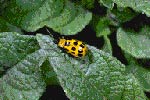
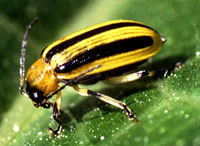 The key insect pests of cucurbit crops are the spotted and
striped cucumber beetles. These two species of beetles are
highly attracted to any of the plants types in this group. It
is common to find the beetles beginning to feed on these
plants the day of transplanting, or the day after. These
beetles also transmit the bacteria that causes bacterial wilt.
For this reason it is important to control these beetles early
in the season, often just after transplanting. Available
controls include foliar sprays, systemic insecticides, and
row covers to exclude the beetles.
The key insect pests of cucurbit crops are the spotted and
striped cucumber beetles. These two species of beetles are
highly attracted to any of the plants types in this group. It
is common to find the beetles beginning to feed on these
plants the day of transplanting, or the day after. These
beetles also transmit the bacteria that causes bacterial wilt.
For this reason it is important to control these beetles early
in the season, often just after transplanting. Available
controls include foliar sprays, systemic insecticides, and
row covers to exclude the beetles.
It has been reported that Bayer has submitted a request to EPA to cancel all uses of fenamiphos, the active ingredient in Nemacur nematicide. This request proposes a three-year phaseout for the chemical.
Nemacur is used for control of nematode diseases in turfgrasses on certain golf courses in Florida and perhaps in certain isolated instances in other states. However, my own experience with turf diseases in Kentucky suggests that nematodes are a minor to nonsignificant component of turf problems in the Commonwealth. Therefore, I do not expect this cancellation to significantly affect disease control in turfgrass in Kentucky.
Four serious pests of landscape trees dogwood borer, bronze birch borer, flatheaded appletree borer, and honeylocust borer are beginning to emerge. The dogwood borer is the most serious pest of ornamental dogwoods, especially stressed trees in full sun. The bronze birch borer is a severe pest of white or paper birch, especially cultivated trees under stress. Flatheaded appletree borers are major pests of red maples, hawthorns, flowering crabapple, and several other hardwoods, especially those which are newly transplanted or under stress. Honeylocust borers are serious pests of transplanted and established urban trees with limited root zones. Mated females of all four species fly to host trees and lay eggs on the bark.
Management -- Borers rarely injure healthy trees or shrubs growing in their natural environments. When transplanted into landscape settings, every effort should be made to minimize plant stresses such as drought, soil compaction, sun scald, lawn mower/weed trimmer injuries, etc. Because newly planted trees are under considerable stress, preventive sprays are advisable during the first 2-3 growing seasons after planting. Timing is crucial in order to have a lethal residue of insecticide on the bark to intercept newly-hatched larvae before they burrow into the tree. Now is about the time to apply protectant sprays for all four species. Lindane or Dursban (chlorpyrifos) are effective, and should be sprayed to runoff on the trunk and main scaffold limbs. A second application, three weeks after the first, provides extended protection.
Although the registration for residential usage of chlorpyrifos has been withdrawn, many retail outlets still have product and existing supplies can be used up. Nonresidential uses by ornamental nurseries and golf courses are still permissible. Permethrin (Astro) may be used as an alternative protectant for borers, although the residual effectiveness may be somewhat shorter.
For further information, see the recently revised extension
publication, ENT-43: Insect Borers of Trees and Shrubs.
The current cool spell is slowing them down but fly pests on dairy farms will make the most of wet breeding sites created by our rainfall pattern this spring. House flies and stable flies deposit their eggs in piles of moist, decaying organic matter including but not limited to, grass clippings, hay, silage, spilled feed, etc. While manure management is an important part of fly control, you can't afford to overlook these other potential breeding sources that can contribute to severe fly problems.
For more information about livestock pests, visit
"Insect Management Recommendations".

Samples diagnosed on agronomic and horticultural crops during the past week included stinkbug injury and wet feet on corn; Aphanomyces root rot on alfalfa; cold injury, herbicide damage, and barley yellow dwarf virus on wheat; Pythium root rot, Rhizoctonia root/stem rot; target spot, angular leaf spot, and bacterial soft rot on tobacco; anthracnose on grape; leaf curl on peach; fire blight, frogeye leaf spot, and burr knot on apple; and Cercospora leaf spot on cantaloupe.
On ornamentals, we have diagnosed nutritional problems from low pH on geranium; anthracnose, powdery mildew, and Botrytis blight on begonia; Fusarium crown rot on carnation; Cladisporium blotch and bud blight on peony; Pythophthora aerial blight and Botrytis blight on petunia; Pythium root rot on impatiens; rosette disease on rose; Entomosporium leaf spot on Photinia; leaf/flower gall on azalea; spot anthracnose on dogwood; Phyllosticta leaf spot, anthracnose and petiole borer on maple; and anthranose on ash.

UKREC-Princeton, KY, May 10 - 20| Black Cutworm
| 0
| True Armyworm
| 5
| Corn Earworm
| 13
| European Corn Borer
| 4
| Southwestern Corn Borer
| 8
| | |
NOTE: Trade names are used to simplify the information presented in this newsletter. No endorsement by the Cooperative Extension Service is intended, nor is criticism implied of similar products that are not named.
Lee Townsend
Extension Entomologist